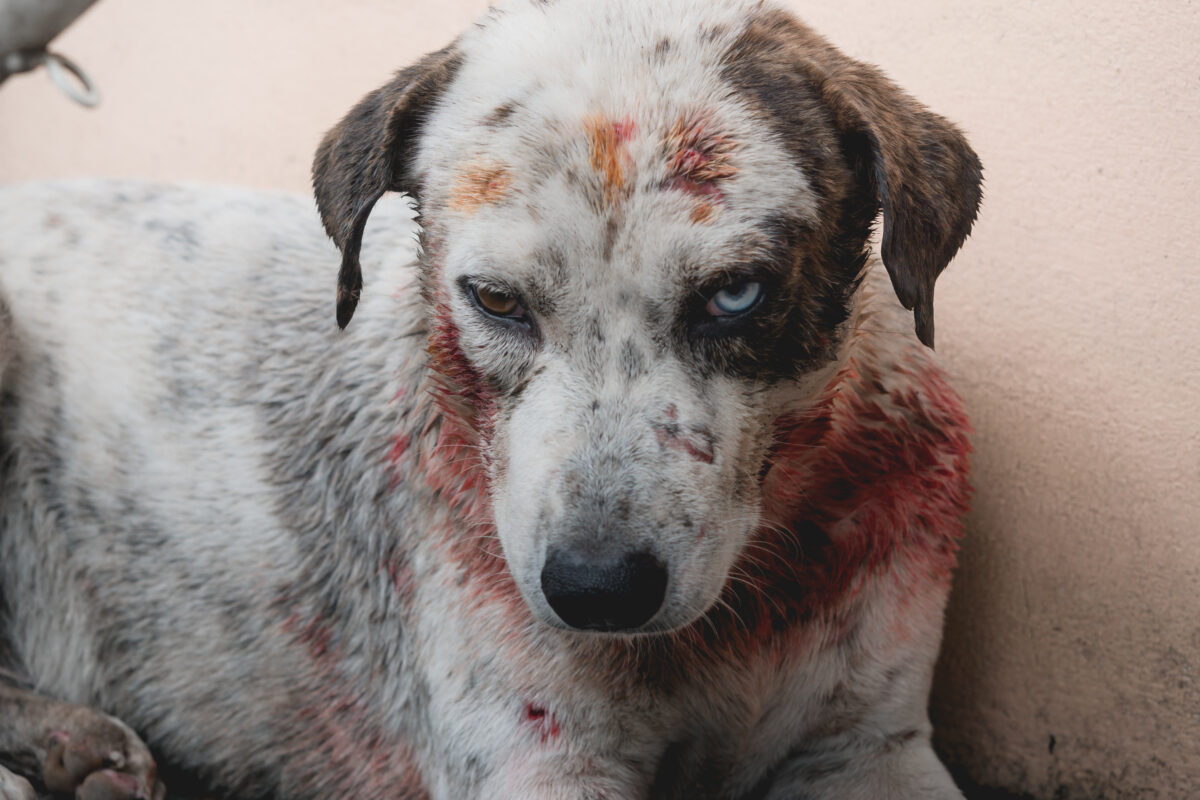Dog Fighting Facts: We Need To Break The Chain
When you purchase through links on our site, we may earn a commission. Here’s how it works.
Dogfighting isn’t just a headline from 2007 or a villain’s hobby in a crime show. It’s alive right now, in suburbs, cities, and rural fields across the country.
Table of Contents
Behind closed doors, thousands of dogs are chained, drugged, and forced into blood sport while bets climb into the six figures. Think it couldn’t happen in your community? That’s precisely the myth keeping it alive.
Dogfighting Myths That Refuse To Die
Think dogfighting ended when Michael Vick went to prison? Wrong.
Think it only happens in shady alleys or faraway states? Wrong again.
An ASPCA national poll found 57 percent of people believe dogfighting never happens in their community. But the ugly truth? It’s hiding in basements, barns, and backyards across the country.
Quick Takeaway:
- Dogfighting isn’t “over.”
- It’s not limited to “bad neighborhoods.”
- It can be happening one street over — and most people wouldn’t know it.
History Of Dogfighting In America
Dogfighting didn’t pop up overnight. It has roots that stretch back centuries.
In the 1800s, the U.S. imported the practice from England, where bull-baiting and animal fights were once considered entertainment. As bull-baiting was outlawed, people shifted to dog-against-dog fights, often in hidden pits behind taverns and barns.

By the early 20th century, dogfighting was still common enough that it wasn’t unusual to read about it in newspapers. Laws began cracking down in the mid-1900s, but by then, the underground network had already been built. This network continues to adapt and remains active today.
What Really Happens In The Fighting Pit
Fighting dogs aren’t raised as pets. Many spend their lives chained to heavy axles, pumped with steroids to bulk up muscle, and isolated to breed aggression.
When they’re finally thrown into the ring, it’s carnage: puncture wounds, blood loss, crushed bones, and worse. Some die in the pit. Others are killed afterward if they “embarrass” their owners by losing.
Dogfighters also use what they call “bait dogs” — weaker, smaller, or submissive animals forced to absorb attacks during training. These dogs are often stolen pets or unwanted animals, sacrificed to sharpen a fighter’s aggression. It’s one of the most brutal tactics in an already cruel world.
Meet Felix: A Rescue Story
When rescuers found Felix, he was chained behind other dogs on a property in South Carolina, hidden from view. Humane World for Animals helped in his rescue during a raid that saved 18 dogs, including two puppies, from alleged dog-fighting operation.
Two days after his rescue, Felix began showing signs of healing: wagging tail, brighter eyes, and a chance at the loving home every dog deserves.
How Widespread Is Dogfighting Today?
Dogfighting is not rare. It is an underground industry that continues to surface in raid after raid.
The ASPCA has assisted with over 300 dogfighting cases across more than two dozen states, helping more than 6,000 dogs escape the pits. In the last year alone, their field teams have aided nearly 350 victims nationwide.
Humane World For Animals operates a national tip line and offers a $5,000 reward for information leading to the arrest and conviction of anyone involved in dogfighting. Its investigations reveal that rings are not limited to a single type of community. They have been discovered in big cities, quiet suburbs, and rural farmland.
Law enforcement has also confirmed the scale. In 2025, the U.S. Department of Justice reported a Georgia case where 14 defendants were sentenced to a combined 343 months in prison for dogfighting and related crimes. The previous year, authorities seized 190 dogs from a single defendant in what became the largest federal dogfighting case involving a single person.
Dogfighting By The Numbers (2024–2025)
- 160+ dogs rescued from 10 sites in South Carolina’s Marion and Dillon counties in the state’s second-largest bust
- 190 dogs seized in a federal case that led to the August 2025 conviction of ex-NFL player Leshon Eugene Johnson, who faces up to 30 years in prison and 1.5 million dollars in fines
- 14 convicted in Georgia’s three-state dogfighting ring in June 2025, sentenced to a combined 343 months in prison
- 22 dogs and puppies rescued from Indiana fighting operations during a July 2025 heat wave
- 17 pit bull–type dogs seized in a Tulsa, Oklahoma, bust in April 2025, with charges including 23 counts tied to illegal fighting
- 100+ dogs rescued and 8 people arrested in southern New Jersey in 2024, in what prosecutors called one of the largest busts in state history
Who Are the Dogfighters?
Contrary to the stereotype, dogfighters are not always shadowy figures in back alleys. They are often people with steady jobs and respected positions in their communities.
In 2023, a Pentagon official was arrested and charged after investigators uncovered his two-decade involvement in dogfighting. Frederick D. Moorefield Jr., a deputy chief information officer at the Department of Defense, was accused of training and fighting dogs for more than 20 years. Moorefield was later sentenced to 18 months in federal prison, six months of home detention, a $20,000 fine, and three years of supervised release for his role in a multi-state dogfighting conspiracy.
The reality is that there is no “typical” dogfighter. They cut across professions, income levels, and neighborhoods. What they share is not a demographic but a willingness to profit from cruelty.
Impact Beyond The Dogs
Dogfighting doesn’t just brutalize animals; it destabilizes entire communities. Police investigations consistently uncover drugs, firearms, and organized crime alongside fighting rings. Where dogfights occur, other forms of violence tend to follow.
It also normalizes cruelty for the people — and even children — exposed to it. Kids raised around dogfighting learn that violence is entertainment and animals are disposable.
That ripple effect makes it more than an animal-welfare issue. It’s a public-safety issue, too.
The Psychology Of Dogfighters
So why do people dogfight?
For some, it’s about money. High-stakes gambling means one “winning” dog can generate thousands in bets.
Others see fighting dogs as symbols of status and power. Owning a “champion” fighter can bolster reputation in underground networks. Researchers studying dogfighters report that notions of masculinity, pride, and social identity frequently come up in interviews.
Research also highlights rationalization techniques, including denying harm done, blaming societal hypocrisy, prioritizing “loyalty” or “family” over other values, or claiming that they are preserving tradition. These tactics help dogfighters reconcile socially abhorrent behavior with the desire to see themselves as “good people.”
Red Flags: How To Spot Dogfighting In Your Community
Dogfighting setups are often hidden in plain sight. If you know what to look for, you can spot them before more dogs are harmed.
Condition Of The Dogs
- Dogs that appear malnourished or unnaturally muscular from forced conditioning
- Multiple scars, especially around the face, chest, or legs
- Torn or missing ears and lips
Environment & Equipment
- Heavy chains or thick collars tied to tires or car axles, leaving dirt rings in the ground
- Training tools like treadmills, spring poles, or hanging bite objects
- Makeshift fighting pits or rings, sometimes built from plywood or fencing panels
Suspicious Setups
- Numerous dogs tethered inches apart, positioned so they can see each other but not touch
- Outbuildings, sheds, or barns with muffled dog noises inside
- Large numbers of Pit Bull–type dogs kept in isolation, often without an apparent reason
If you see several of these signs together, do not ignore them. Report what you observe to law enforcement or animal control. A single call could save lives.
See The Signs Firsthand
In September 2022, federal officials seized 275 dogs from alleged dogfighting operations across multiple South Carolina properties. The dogs lived outside in pens or on chains with only barrels or makeshift shelters for protection. Many were thin, dehydrated, and in critical condition.
Watch the ASPCA Animal Rescue Team care for survivors and see how these operations are often hidden in plain sight.
What To Do If You Suspect It
In an ASPCA national poll, only half of the people who suspected dogfighting reported it to the police. A quarter did nothing at all.
The reality is that shelters cannot stop this. Social media posts cannot stop this.
Only law enforcement has the power to shut down fights and prosecute offenders. And you can call anonymously.
Do This, Not That
- Call local law enforcement first. They have the authority to investigate.
- Call local animal control for guidance or backup reporting
- Do not confront dogfighters yourself
- Do not just post about it online
Dogfighting is a felony. Offenders face severe fines and prison time, but only if someone speaks up.
The Dogs Who Survive (And Those Who Don’t)
Some dogs rescued from fighting rings find second chances. With foster homes, medical care, and patient love, they can live out their days as beloved pets.
Others aren’t so lucky. Severe injuries, trauma, or breed stigma mean many are euthanized. For them, intervention came too late.
This contrast is why awareness matters: the earlier these rings are reported, the more lives can be saved.
Join The Fight: How You Can Help End Dogfighting
Every report, donation, or conversation chips away at the secrecy that keeps dogfighting alive. The more people who know the signs and take action, the fewer dogs will suffer in silence.
What You Can Do Right Now
- Report suspicious activity directly to the police.
- Share credible information on social media to debunk myths and raise awareness in your community.
- Support local shelters and rescues that take in dogfighting survivors by donating supplies, funds, or volunteering your time.
- Advocate for stronger laws and enforcement in your state by contacting local representatives.
- Educate kids and neighbors about humane treatment of animals to counter the normalization of cruelty.
Frequently Asked Questions
Dogfighting thrives on secrecy and misunderstanding, which means many people are unsure what’s legal, how it operates, or what to do if they witness it. These FAQs break down the most common questions and misconceptions so you can spot the signs and take action.
Don’t see your question? Ask us in the comments.
Is Dogfighting Illegal Everywhere In The U.S.?
Yes. Every state, along with Washington D.C., Puerto Rico, and Guam, treats dogfighting as a felony offense. Courts can sentence people who organize, promote, or participate in fights to prison, impose heavy fines, and assign a lifelong criminal record.
Many states also criminalize attending a fight, even if you do not step into the ring. Lawmakers targeted spectators because crowds placing bets fuel the underground industry. Watching a fight carries the same criminal weight as orchestrating one.
How Do People Get Away With Dogfighting If It’s Illegal?
Dogfighters hide their activities with secrecy, coded language, and hard-to-trace locations. They often stage events in barns, basements, or secluded fields, and they warn participants about potential raids.
Communities often dismiss or ignore suspicious setups because they do not believe dogfighting could exist in their own area.
The culture of silence adds to the problem. Many people who suspect dogfighting choose not to call the police.
Fear, confusion, or the false belief that animal control can handle it often prevents reporting. This silence allows dogfighters to operate for years without consequences.
What Happens To Dogs Rescued From Fighting Rings?
Some dogs make incredible recoveries. With the right foster families, medical care, and training, survivors can thrive as beloved companions.
Shelters often highlight these success stories, showing once-chained dogs curled up on couches, learning trust again. These transformations prove that fighting dogs aren’t “born violent” — they’re made victims.
But not all rescues end happily. Severe injuries, untreated infections, and emotional trauma can make rehabilitation difficult or impossible. Breed stigma also works against survivors, since Pit Bull–type dogs are often unfairly labeled as dangerous.
The earlier a dog is rescued, the better their chances of recovery.
What Breeds Are Most Often Used In Dogfighting?
Dogfighters most often exploit Pit Bull–type dogs because of their strength, stamina, and loyalty. They twist that loyalty into aggression by using isolation, starvation, and beatings.
Historically, dogfighters have also used other muscular breeds, such as Mastiffs or Bulldogs.
In reality, the breed matters less than the person handling the dog. Any strong dog can end up in a fight if someone intends to profit from cruelty.
How Can I Report Dogfighting Safely?
The safest option is to contact your local police department. Law enforcement officers have the training and authority to investigate and prosecute these crimes, and many departments allow anonymous tips if you’re worried about retaliation. If you’re unsure who to call, animal control can also direct you to the right agency.
The key is to act quickly and provide details, even if you’re not 100% certain. A vague suspicion is better than silence, and professionals can determine whether further investigation is needed.
Why Should I Care If I Don’t Own A Dog?
Dogfighting isn’t just an animal welfare issue. It’s deeply connected to other crimes like illegal gambling, drug trafficking, and weapon sales. Communities with active fighting rings often experience ripple effects of violence and crime that extend far beyond the dogs themselves.
On a moral level, it’s also about refusing to normalize cruelty. Dogs forced into fights suffer unimaginable abuse, and tolerating that abuse erodes compassion in society as a whole.
Standing against dogfighting is standing for safer, kinder neighborhoods, whether or not you share your home with a pet.
Ready To Help Dogs In Need?
Dogfighting is not a relic of the past, and every small action chips away at the secrecy that keeps it alive. You can make a difference by fostering a dog in need or by learning to read dog body language so you can better understand and protect them. Compassion starts with awareness, but it grows when people choose to act.



